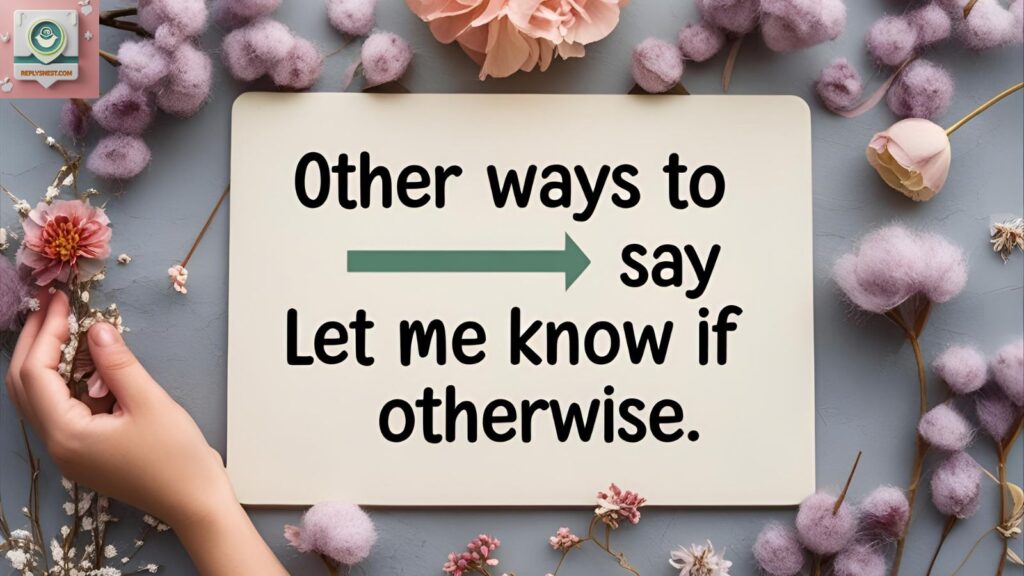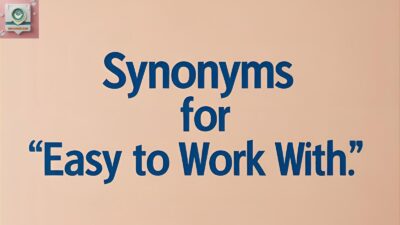When writing or speaking in a professional setting, knowing the right phrase can change the tone of your message entirely. Instead of saying “Let Me Know If Otherwise,” I often prefer using more natural, context-sensitive alternatives especially when working on a project plan or sharing a strategy update with a client. For instance, when preparing a report due on Friday, I’ll typically write, “Keep me posted if there’s any variation” or “Drop me a line if you disagree.”
These phrases feel more courteous and polite, and they also show that I’m receptive to other opinions. Whether it’s a brief confirmation of a shipment update or a heads up about changes in the venue, being mindful of how you communicate helps everyone remain open and respectful.
During a meeting about a marketing strategy, someone might flag a few issues or suggestions. That’s when saying “Let me in on any adjustments” or “Notify me of any deviations” feels more like an invitation to connect than a command.
In my experience handling event logistics and juggling budgets, using phrases like “Keep me in the loop” or “Tell me if anything needs to be revised” shows I value collaboration. It also helps us handle discrepancies, avoid misalignments, and speed up the implementation of refinements.
No matter if we’re finalizing a design concept or aligning on figures from a document, how we phrase our requests reflects our understanding, perspective, and desire to support. It’s not just about instructions it’s about maintaining clear communication throughout every shift, whether it’s at 10 AM on a Tuesday or a long session in the conference room.
1. Please let me know if this works for you
This phrase sounds warm, considerate, and shows that you’re being thoughtful about the other person’s preferences.
- Best Use: Scheduling a meeting or confirming a plan
- Not to Use: When discussing policies or decisions that are already finalized
- Alternative Phrases: “Does this sound good to you?”, “Would that be okay?”
- Example: “I’ve scheduled the call for 2 PM Thursday please let me know if this works for you.”
Read More: Best Responses to “Old Is Gold”
2. If there’s anything different you had in mind, feel free to share

This version opens space for collaboration and creative input.
- Best Use: Brainstorming, feedback loops
- Not to Use: When expecting a clear yes or no answer
- Alternative Phrases: “Open to thoughts?”, “Feel free to adjust”
- Example: “Here’s the draft version if there’s anything different you had in mind, feel free to share.”
3. Let me know if this needs to be revised

Helpful when you’re submitting drafts or project plans.
- Best Use: In writing or design-related discussions
- Not to Use: Casual texts or short emails
- Alternative Phrases: “Happy to tweak if needed”, “Let me know what to fix”
- Example: “Here’s the copy for review let me know if this needs to be revised.”
4. I’m happy to make changes if needed

This shows flexibility and a willingness to adapt.
- Best Use: Working with clients or team projects
- Not to Use: When you’re setting final terms or conditions
- Alternative Phrases: “Open to edits”, “Let me know how I can improve it”
- Example: “Please review the outline I’m happy to make changes if needed.”
5. Feel free to correct me if I’m mistaken
Perfect when sharing information that you’re not 100% certain about.
- Best Use: Knowledge-sharing, collaborative environments
- Not to Use: When expressing a firm opinion or policy
- Alternative Phrases: “Please correct me if wrong”, “Let me know if I missed something”
- Example: “I believe the deadline is next Friday feel free to correct me if I’m mistaken.”
6. Let me know if something else would be better
Gives the receiver an opportunity to suggest a better alternative.
- Best Use: Offering solutions or suggestions
- Not to Use: When timelines or rules are non-negotiable
- Alternative Phrases: “Open to better ideas”, “I’m flexible if needed”
- Example: “I’m proposing this layout let me know if something else would be better.”
7. Does this align with what you had in mind?
This is a tactful way to check if you’re on the same page.
- Best Use: Creative collaboration or planning
- Not to Use: One-way communications or confirmations
- Alternative Phrases: “Is this in line with your vision?”, “Is this what you expected?”
- Example: “Here’s the revised proposal does this align with what you had in mind?”
8. Let me know if you’d prefer something else
A polite way to offer an alternative without sounding pushy.
- Best Use: Client services, customer support
- Not to Use: Formal job applications or legal documents
- Alternative Phrases: “Happy to switch things up”, “Open to preferences”
- Example: “We’ve reserved a table at 7 let me know if you’d prefer something else.”
9. Just say the word if you need a change
This sounds casual and friendly while still showing respect.
- Best Use: Informal conversations or internal teams
- Not to Use: Professional or high-stakes negotiations
- Alternative Phrases: “Let me know anytime”, “Easy to update”
- Example: “I’ve finalized the slides just say the word if you need a change.”
10. Please advise if there’s anything I missed
A humble, respectful approach to checking accuracy.
- Best Use: Formal reports, documentation
- Not to Use: Friendly check-ins or casual meetings
- Alternative Phrases: “Let me know what’s missing”, “I’d appreciate your input”
- Example: “Here’s the summary of today’s call please advise if there’s anything I missed.”
11. Let me know if I should look into other options
This signals that you’re proactive and ready to adjust course.
- Best Use: Project planning or troubleshooting
- Not to Use: Already finalized processes
- Alternative Phrases: “Should I explore alternatives?”, “Want me to dig deeper?”
- Example: “I’ve suggested these tools let me know if I should look into other options.”
12. Is this approach okay with you?
A softer way of checking in before proceeding.
- Best Use: Teamwork, shared decision-making
- Not to Use: When deadlines are tight
- Alternative Phrases: “Are you good with this?”, “Want to try another route?”
- Example: “We’re thinking of starting with phase one is this approach okay with you?”
13. Let me know if I misunderstood anything
Shows you’re actively listening and open to correction.
- Best Use: Following up on meetings or instructions
- Not to Use: Cold emails or one-way messages
- Alternative Phrases: “Clarify anything I got wrong”, “Hope I captured it right”
- Example: “Here’s my takeaway from our chat let me know if I misunderstood anything.”
14. I’m open to suggestions
Encourages input and promotes open dialogue.
- Best Use: Creative environments, planning sessions
- Not to Use: Compliance tasks or legal writing
- Alternative Phrases: “Love to hear your thoughts”, “What would you change?”
- Example: “Here’s my initial layout I’m open to suggestions.”
15. Happy to adjust if needed
Short, sweet, and supportive.
- Best Use: When discussing flexible plans
- Not to Use: When standing firm is required
- Alternative Phrases: “Easily changeable”, “Can revise it”
- Example: “This is the itinerary happy to adjust if needed.”
16. Let me know if we should take another route
Signals flexibility in strategy or decision-making.
- Best Use: Strategic conversations
- Not to Use: Simple logistics
- Alternative Phrases: “Should we rethink it?”, “Another path you prefer?”
- Example: “This is our current rollout plan let me know if we should take another route.”
17. Would love your thoughts on this
Invites feedback in a warm, inclusive tone.
- Best Use: Creative brainstorming, content review
- Not to Use: Policy-related matters
- Alternative Phrases: “Thoughts?”, “What’s your take?”
- Example: “I’ve attached the pitch deck would love your thoughts on this.”
18. Feel free to point me in the right direction
Casual and collaborative, especially when unsure.
- Best Use: New projects, unfamiliar topics
- Not to Use: Final reports or submissions
- Alternative Phrases: “Happy to be corrected”, “Help guide me if needed”
- Example: “Still learning the process feel free to point me in the right direction.”
19. Let me know if I should change anything
Very direct and helpful, especially with tasks or files.
- Best Use: Design, writing, tech work
- Not to Use: Informal group chats
- Alternative Phrases: “Need any edits?”, “All good, or tweak needed?”
- Example: “Attached are the visuals let me know if I should change anything.”
20. Let me know if we’re missing something
A great phrase to double-check completeness.
- Best Use: Group tasks or checklist reviews
- Not to Use: Solo updates or direct confirmations
- Alternative Phrases: “Are we good to go?”, “Anything else to add?”
- Example: “Here’s the project tracker let me know if we’re missing something.”
21. Feel free to suggest improvements
Invites constructive feedback, useful in iterative work.
- Best Use: Draft work, early-stage content
- Not to Use: Performance reviews or evaluations
- Alternative Phrases: “Any changes?”, “Your input is welcome”
- Example: “I’ve uploaded the campaign plan feel free to suggest improvements.”
22. Let me know if you’d like something different
Friendly and accommodating.
- Best Use: Sharing options or services
- Not to Use: When options are limited
- Alternative Phrases: “Want a change?”, “Does this suit you?”
- Example: “Here’s your menu selection let me know if you’d like something different.”
23. Tell me if you see it another way
Welcomes different perspectives.
- Best Use: Discussions, negotiations
- Not to Use: When expecting agreement only
- Alternative Phrases: “Do you feel differently?”, “What’s your view?”
- Example: “I see this as a priority tell me if you see it another way.”
24. Let me know if I need to take another approach
Great for gauging fit and direction.
- Best Use: Strategy, planning
- Not to Use: Casual conversations
- Alternative Phrases: “Want me to pivot?”, “Should we change direction?”
- Example: “I’ve outlined the workflow let me know if I need to take another approach.”
25. Does this meet your expectations?
Professional, especially when wrapping up tasks.
- Best Use: Deliverables, client work
- Not to Use: Informal planning
- Alternative Phrases: “All good on your end?”, “Satisfied with this?”
- Example: “Here’s the completed file does this meet your expectations?”
Conclusion: Finding the Right Words Builds Better Connections
Effective communication isn’t just about being correct it’s about being considerate. Swapping out a flat “let me know if otherwise” for something more thoughtful can turn routine messages into opportunities to build trust, spark collaboration, and show genuine care.
From client emails to team Slack chats, these phrases make your tone more human, humble, and open which in turn encourages better responses and fewer misunderstandings. Personally, I’ve found that just one small change in tone often leads to better outcomes and stronger working relationships.
So next time you’re tempted to write “let me know if otherwise” try one of these friendlier, more intentional alternatives. Trust me, it makes a difference.



